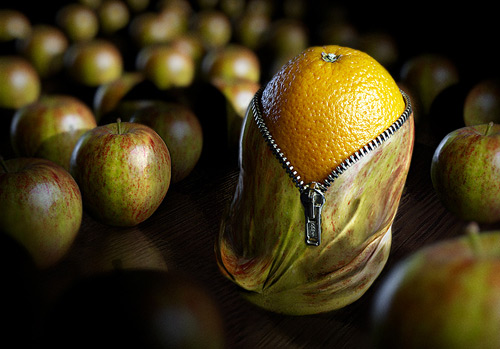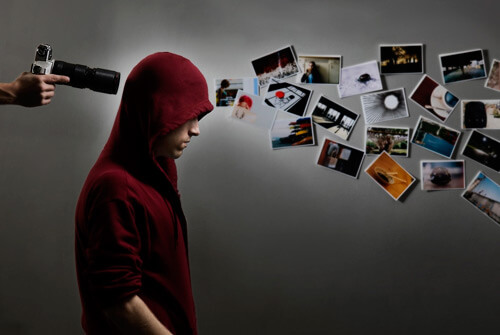Chuck Close is an American painter and photographer who is known for his photo-realism and massive paintings. I first heard of him on the Colbert Report and was intrigued by his style of art. He creates paintings by using a process called gridding. This process basically involves composing a painting out of small blocks, and he makes each block an abstract art piece. What I found interesting about him is that despite having Prosopagnosia, which is also known as face blindness, he specializes in portraits. He claims that he didn't know his wife's face two years in to his marriage. He remembers faces by flattening them into the paintings that he creates, as the face blindness is caused by errant depth perception. Click here for photo gallery. Here are some of his paintings that I liked:
Tuesday, December 14, 2010
Tuesday, December 7, 2010
Progression of Art Styles
As we all know art styles have radically changed over the centuries. But it was only until I actually looked up the progression of art styles in history that I realized how many different types of art styles there are, and that's just in painting. We have touched on a few of the styles in class, such as cubism. This style was sparked by the invention of the camera, now people could see images from any perspective that the camera could reach. Cubism takes this idea and represents many points of view on the same image, creating a distorted image of the original subject. And it is the introduction of a new view point that always sparks new styles. Another example is Abstract art, this was created because some artists believed that there was no need to represent real objects. Instead they chose to change the view point to interpret colors and shapes that are not recognizable and portray their message through vaguer images. What I found interesting is that there have been no radical style shifts in art in the 21st century.
One art style that i found interesting is Kinetic Art. This style explores how things look when they move and usually involves parts that are designed to set in motion by some internal mechanism. This type of art developed in response to technological advances, using motors and sensors to create motion. This is especially interesting to me as I am majoring in mechanical engineering, the idea of machines being piece of art is intriguing.The motion cannot be captured by images, and is better viewed in videos.
http://www.youtube.com/watch?v=WcR7U2tuNoY
http://www.youtube.com/watch?v=50eWUdyKGxE
One art style that i found interesting is Kinetic Art. This style explores how things look when they move and usually involves parts that are designed to set in motion by some internal mechanism. This type of art developed in response to technological advances, using motors and sensors to create motion. This is especially interesting to me as I am majoring in mechanical engineering, the idea of machines being piece of art is intriguing.The motion cannot be captured by images, and is better viewed in videos.
http://www.youtube.com/watch?v=WcR7U2tuNoY
http://www.youtube.com/watch?v=50eWUdyKGxE
Sunday, December 5, 2010
MoMA website
We have recently been discussing museums and focusing on the web design choices these museums make. Most of the museum websites have very interactive websites that have high quality graphics that work smoothly and integrate with the art to present a seamless user interface for viewing art and searching for exhibits. One website that is a good example of such seamless integration is the Museum of Modern Art website. This website has a vast number of galleries for view online, but they have managed these galleries to make easy to navigate and enjoy the galleries. In terms of visual design the website embodies the word clean, they use light colors highlighted with brighter colors that pop and everything is linear and structured. I believe this visual design has been chosen to reflect modern art which follows the same aesthetics. One thing I did notice about this website thought, is that every page you visit has a button to send you to the MoMA shop. This gives me the feeling that MoMA is very retail oriented.
Stolen Art
Whenever I see art in popular media it is usually about art being stolen from museums, but the fact is that much of the art in museums are stolen from other people in the fist place. Most of this art is attained from colonization or as wartime loots. An example of wartime looting is during the World War 2. The Nazis stole art from Jewish families and other victims of the expansion of Nazi Germany. I was surprised to see that I recognized some of the art that was stolen. There was the “Portrait of Dr. Gachet” by Vincent Van Goh and also a sculpture by Michelangelo called “Madonnas of Bruges”.
This is a controversial topic in the art world. Should we return the art to its original and, some would say, rightful owners? Some museums sympathize with this view and return most of the art, although sometimes keeping important ones. It is a complicated matter, especially when the art in question has been engraved into a new society and embedded into its culture.
Saturday, December 4, 2010
Museums
I had never thought about how art is displayed to us could affect our view of it, it seems like a basic idea but is a very interesting one. O’Doherty makes the point that what we are viewing in museums is in fact something that has been editorialized, just like a magazine, by a curator. Many choices have to be made in displaying a exhibition, the art pieces have to be displayed in an organized fashion in order to make a coherent point and to educate the average viewer, how much space does each painting have for itself. The environment in which you view art is important and definitely impacts your view of the art.

This can be exemplified by examining different environments. The one I am most familiar with is the contemporary design used in museums today, this is the design in which I viewed the titian Exhibit and the Dali Exhibit. The contemporary designs main objective is to reduce distraction and let the viewer focus solely on the art and its message. Many art pieces reside in places of worship such as cathedrals, here every architectural detail is tweaked to emphasize grandeur. Grand arches outline murals, creating windows into important religious events. Murals are placed on huge domed ceilings often lined with gold paint. Here we can clearly see that the environment influences our view of the art.
Sunday, November 28, 2010
Propaganda
Expanding on the idea of art acting as an agent in our societies, Propaganda’s sole purpose is to act upon and influence society through the medium of posters, ads, etc. towards a specific cause or view. I chose to focus on war propaganda as they are the most abundant and personally are more interesting. Racial prejudices and stereotypes run rampant in war propaganda as well as patriotic symbols such as flags. This form of propaganda was used in World War 2 to recruit men into the army and to raise money for the war, appealing to fear and heroic ambition. American posters during this time mainly depicted axis leaders in antagonistic symbols such as snakes, and many appealed to buy war bonds. On the other side the Nazis use propaganda to the furthest extent, molding every form of media to display some message that influenced the German people’s views. Nazi Germany is a very interesting environment in which to examine just how much art influences us. Nazi propaganda was mostly filled with anti-Semitic messages, depiction of Americans as monsters and messages convincing the population of the country’s productiveness and military prowess.
Role of Art in Societies
I have always thought that changes in art happen at a time when our view is influenced by some outside element. This could be an invention such as a camera, or it could be something as pivotal as a revolution such as the French Revolution which sparked many changes in French art. I came across and interesting essay by composer Richard Wagner who examines the role of art thoroughly and discusses its degradation through time. He believes the highest conceivable form of art to be Drama, and it is from this point on that the degradation begins. As Greece is absorbed in the Roman Empire Drama gives way to philosophy. He believed that the Christians did not create art for the very joy of it but instead as an offering to their God, when instead they should offer in deeds and not objects. It is from here that Wagner notes that changes in society have caused art to sell 'her soul and body to a far worse mistress - Commerce.' Art is split into two categories here, Opera and plays. He says that plays lack ‘the idealizing influence of music’ and operas ‘forestalled the living heart and lofty purpose of actual drama’. Although I do not agree with Wagner’s view that the newer forms of art are a degraded subdivision of the “original” art of drama, his examples of how art has changed through cultural changes help understand the role of art better.
Titian Exhibit
Last Thursday I went to the High Museum to view the traveling exhibition displaying works of art from the golden age of Venetian paintings, the main focus on Titian and his Diana paintings. As our assignment was to analyze the lay out of the exhibition, I found myself just glancing at the works of art and focusing on their placement, the color of the room and the room layout. But this exhibition forces you to view the art as you cannot view the exhibition highlight (Diana paintings) without first seeing the sketches that were the development of the Venetian style. When I did finally reach the main paintings I was first surprised for a moment at the bold nudity that was displayed in the paintings. This theme of nudity runs through both Diana paintings, almost connecting the two into one image. The paintings made no sense to me as I am not familiar with the stories they try to depict. Although I was certainly impressed by the detail that the artist captured, the realism was at a stark contrast with Dali’s exhibit, which I previously viewed.
We recently talked about the lack of recognition of talented female artists and their under representation in museums, who instead favor male artists. This exhibition clearly displayed that this trend has been in place for some time and continues to dominate museums today. The Titian Exhibit displays art pieces solely by male figures, a the title of the exhibit suggests. The previous exhibit I viewed (Dali’s Exhibit) follows the same trend. I find it hard to believe that such inequality can still exist, what makes a male artist any better than a female artist?
Sunday, November 21, 2010
The Photo Argus
Presentations
I found the many different points of view that were displayed in the presentation very interesting. Although some of us had similar pictures we had completely different takes on them. Although popular culture tends to direct our thinking by telling us what we should think, we still end up with completely different views on the same subject. I was intrigued by the presentation that zoomed in on one object and slowly zoomed out, showing how context affects our view. This was a very unique and fascinating theme choice.
Visual Essay Project
The visual essay project was deceptively hard mainly because of the large amount of possibilities of themes and ensuring that each picture made a point in that theme. But after choosing the theme, which changed a few times over the course of the project, it was easier and much more interesting. This project taught me the true value of public art in our communities, and thus my theme was centered on the idea of communities. An interesting aspect of this project was photo editing, I did not make any major alterations to my pictures but I did mess around with them in Photoshop. In order to focus on the public art more I took out any distractions in my pictures. This included people, cars, etc., anything that wasn’t a permanent part of the environment. This was definitely a new style of presentation for me, and I found it quite effective and interesting.
Abstract Photography
This form of photography aims to take pictures that have no clear or discernible subject or the subject appears like an entirely unlike object. This intrigued me, how does someone take something real and make it appear such that no meaning can be discerned. As I looked up how such a thing could be achieved, I saw many pictures that I really liked. Most of the pictures were composed such that parts of a subject could be seen but not enough as to recognize the subject. Many were taken in form of macro photography which I have discussed earlier, focusing and zooming in until we can no longer see the bigger picture. Contradictory to my blog on abstract art I actually enjoyed the photographs that I came across. Instead of hopelessly looking for a meaning like I did in the paintings I instead found it setting a mood. I believe this difference emerges from the fact that it is something real, as much as the photographer augments our point of view, what we are seeing is in fact something tangible and real unlike the apparently empty lines and colors of abstract art. They consist of natural colors, natural lines and curves, and natural lighting for the most part. This brings in another previous blog on photo editing; a lot of this is implemented in order to impart the right mood through the photograph.
Thursday, November 18, 2010
Public Art
 The definition of public art is any painting or sculpture designed to be displayed in public open space or art that is envisaged as part of the life of the community in which it is sited. The second part of the definition is what interested me more. Public art had to be something that was integrated into our communities and represents the ideals of the community. I decided that this would be my theme, exploring how this definition played out in different communities. I found that in general the public art in the communities I studied did indeed represent the qualities and ideals of that community. What I found interesting was that I did not require extensive amounts of context for me to understand those values; instead I built the community around the public art through understanding it. And I could also clearly see the integration of the public art in the lives of the people living there. Many sat by the public art, if not admiring the aesthetic appeal then just appreciating the environment that public art creates.
The definition of public art is any painting or sculpture designed to be displayed in public open space or art that is envisaged as part of the life of the community in which it is sited. The second part of the definition is what interested me more. Public art had to be something that was integrated into our communities and represents the ideals of the community. I decided that this would be my theme, exploring how this definition played out in different communities. I found that in general the public art in the communities I studied did indeed represent the qualities and ideals of that community. What I found interesting was that I did not require extensive amounts of context for me to understand those values; instead I built the community around the public art through understanding it. And I could also clearly see the integration of the public art in the lives of the people living there. Many sat by the public art, if not admiring the aesthetic appeal then just appreciating the environment that public art creates.
Subscribe to:
Posts (Atom)





















